Linderhof Palace, Bavaria, Germany
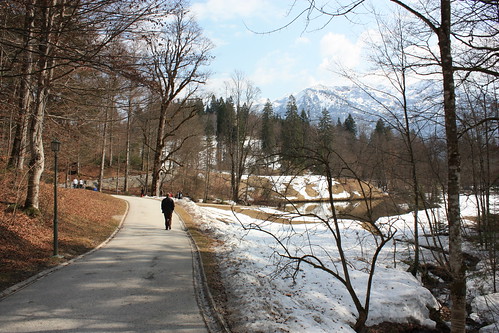
The walkway to Linderhof Palace, Bavaria.
–
Do you ever get the feeling that you’ve forgotten something?
It’s a sensation I absolutely hate, and I think that’s part of the reason why I’m always doomed to feel that way. I can’t leave the house without being convinced that I forgot to put something important in my purse (like my wallet or my phone or the emergency granola bar that I keep eating and needing to replace). Or that I left my straightening iron plugged in, or the iron on, or I somehow managed to set the kitchen on fire and it’s now engulfed in flames that I failed to notice as I waltzed out the front door.
These worries seize my heart and mind and can turn any pleasant outing into one fraught with worry. It doesn’t help that I now no longer trust my brain. Not one bit. It’s a deviant and unreliable sucker, and it absolutely refuses to give me any clue as to some of the things I may have said and done during the week after my surgery. Rand swears that all I did was sleep and eat and talk about food, and I’m inclined to believe him because that sounds like me, BUT STILL.
The point is, I hate forgetting things or thinking that I’ve missed something. And while looking through some old photo sets, I realized that I’ve done just that. Even more tragically, I did so when it comes to one of the most notable characters in German history.
I forgot to tell you about King Ludwig II of Bavaria – affectionately known as “Crazy King Ludwig”, or “Mad King Ludwig”, or “Ludwig who really needs a financial planner” – and his glorious palace in Linderhof.
Ludwig was an odd duck. He hated social events (it may have been Social Anxiety Disorder or some extreme form of misanthropy. Some even postulate that he was struggling with his sexuality at a time when being gay was barely acknowledged, much less accepted, and couldn’t face being around others), and went to great lengths to be alone. According to our guide, servants would avoid Ludwig (at his request), and when they did see him, they pretended not to.
Here I go, walking into the king’s entirely empty bedroom. I certainly do NOT see the regent, who is sitting on the divan, hiding behind a frilly pillow. NOPE.
Linderhof is not the most famous or grandiose of Ludwig’s homes. That would be Neuschwanstein, which is massive and lovely. Those of you who grew up at a time before we realized television was bad for children will note that it looks familiar – it’s the castle upon which Disney modeled Cinderella’s. At the time, Neuschwanstein was regarded as an excessive waste of resources, the cost of which were part of the reason Ludwig was deposed as king. He did not live to see the castle completed, and spent only a few nights there during its construction. After Ludwig died (under mysterious circumstances), the castles and palace that he built – once a sign of his excess and incompetence – served to generate a great deal of tourism income for Bavaria, and still do to this day.
I’ve visited Neuschwanstein before, but that was years ago, long before I had a blog and – crazy as this sounds – before I had a reliable digital camera (dude, the mid 00s were like the Dark Ages, right?). So I’m not going to write about that, but instead tell you about the relatively-modest-by-comparison palace of Linderhof, that Rand and I visited just this past spring when we were in Bavaria.
Linderhof is by far the most sentimental-feeling of Ludwig’s homes, and the only one that was completed during his lifetime. It was built on the grounds where the king had summered as a boy, and the area was near and dear to him. The castle itself is not far from Ettal, but it’s a bit challenging to try to do both in one day, and you likely won’t have lots of time left for eating strudel and schnitzel and all those other incredibly delightful German dishes that simultaneously make your stomach happy and your arteries scream.

It may not look like a big deal from the outside, but it’s the amount sheer opulence inside that counts.
–
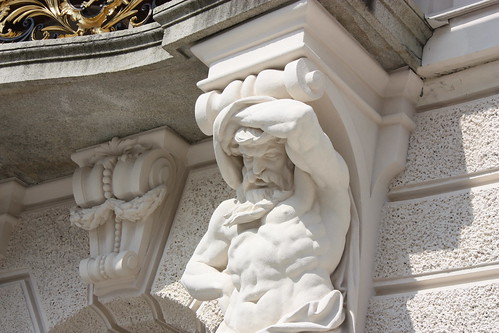
Detail of a statue at the front of the palace. Rand’s abs look just like this. Really.
–
The grounds are lush and green, dotted with ponds filled with beautiful but aggressive swans who will not hesitate to steal Cheetos from the hands of some obnoxious American teenagers (Ludwig was, in fact, known as “The Swan King.”)
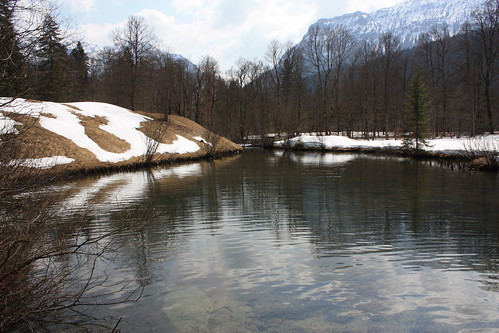
Note: we were there in March, and while there was still snow on the ground, it was plenty warm.
–
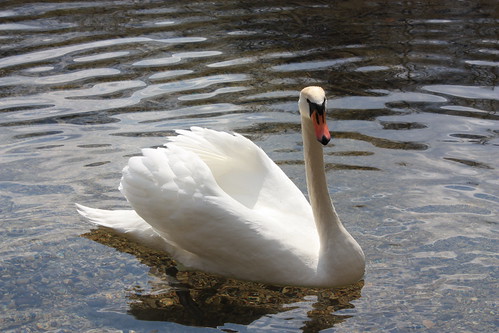
Just don’t get any orange “cheese” on that lovely coat of yours, okay darling?
–
Ludwig designed Linderhof as a miniature Versailles. Aesthetically, I understand his reasons, for Versailles is supposedly gorgeous, but it seems to me that if you were the eccentric leader of a European country, you might want to steer clear of emulating the excesses of the French royal family. I’m just saying. (Note: I realize that Ludwig idolized Louis XIV, and it was Louis XVI who was executed during the French Revolution, but still.)
At the entrance to Linderhof is this crest, paying homage to Louis XIV, the sun king:
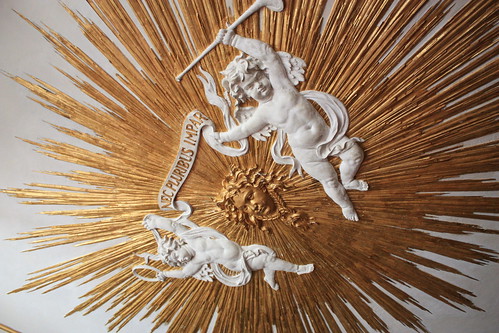
–
And now here’s the bad news. There is no photography allowed inside the castle. None at all. But I can share with you some of the highlights, thanks to the internet (you can do a virtual tour of the palace on their website, too):
- There is a room covered in mirrors. The Hall of Mirrors, as it was aptly named, was specifically modeled after one in Versailles, and at night it would be filled with candles. Ludwig would sit there alone and read for hours and hours.
– - The upstairs dining room, where Ludwig ate, had a large section of floor that could be lowered – along with the table and chairs that stood on it – into the kitchen. This way the staff could set the table with food and drink, and then raise it back up – via a system of pulleys – so that the king could eat without ever having to talk to or see anyone.
– - His bedroom features a mattress which is, rather counter-intuitively, barely king-sized (it was easier to warm up a smaller bed). It is on a raised platform covered in blue tapestry and gilded gold, because even if he snored or drooled on his pillow, an unconscious king is still a king, damn it.
– - There are some serious candelabras in this place (not like those dinky candelabras we’re used to these days). One is massive and made of ivory, another is massive and made of glass. They both hang overhead, and while I’m sure they’re secure, it seems unwise to stand under them, lest you wish to be the victim of a murder of theatrical proportions.
Oh, and here’s a bit more bad news. I began this post complaining about how much I hate forgetting things – how the sensation that I might have overlooked or missed something will drive me absolutely bonkers. It turns out, when we went to Linderhof, we missed quite a lot. Many of the statues and the elaborate gardens that surround the palace were still closed off. They’re covered every winter to protect them from the harsh Bavarian elements, and when we were there in March, they’d yet to unveil them.
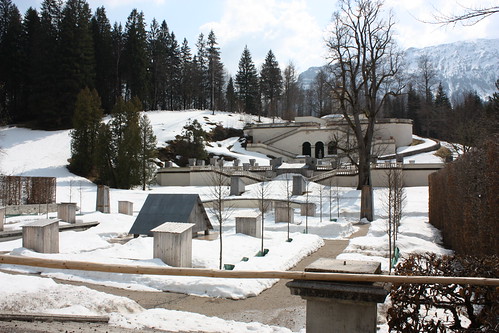
–
We also missed numerous other features of Linderhof Park (many of them were closed due to weather, or tickets were unavailable), including the Venus Grotto, which looks absolutely surreal. I’m rather upset about all this. It’s like returning home and finding that you did leave the curling iron on after all. It also meant that while we were waiting for our palace tour to start, we couldn’t visit the gardens. We had to pass the time like this …
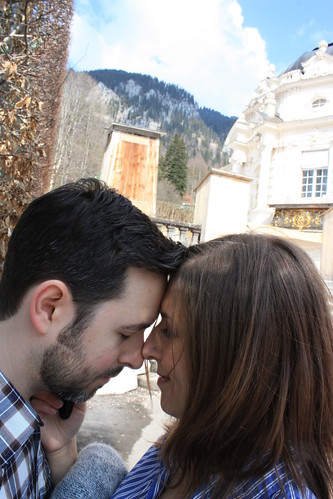
–
And this …

–
And this …
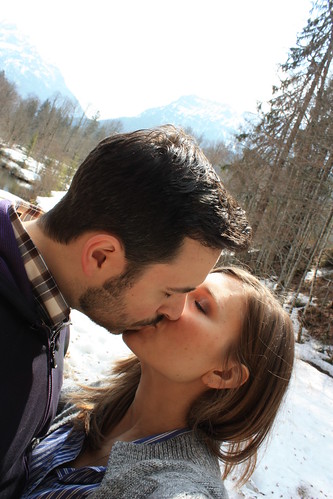 –
–
You know, in hindsight, I suppose it wasn’t all that bad, having to while away long, sunlit minutes making out with my husband. It makes me feel miserably sad for poor old Ludwig. He may have claimed to like the solitary life, may have been surrounded by gilded gold and ivory and beautiful things … but man, he really missed out.
—————
The Essentials on Linderhof Palace:
- Verdict: Yes. This place might be the least impressive of Ludwig’s castles, but it is still well worth a visit. Give yourself a few hours (the tour of the palace alone takes about 50 minutes) and time to explore the gardens and the surrounding park.
– - How to get there: You’ll need to go by car. The palace is about 60 miles from Munich, and with traffic and winding roads, should take you about an hour and half to get there. You might want to consider booking a tour that leaves from Munich, if you are going to spend several days in the city and don’t want to drive. There’s also a train, but it will require you to transfer onto a bus and … ugh.
– - Ideal for: History and architecture lovers; anyone who, like me, is amazed by shiny things.
– - Insider tips: For the love of all that is holy, don’t do what we did and MISS GOBS OF AWESOME STUFF in the park and gardens. Contact the palace and park ahead of time to see if all parts of the park are open (they usually are in late spring and summer), and make sure tickets are available for palace tour (you can’t see the inside of the palace without a ticket to the guided tour). You can also reserve tickets ahead of time, but – I KID YOU NOT – you will have to print out the form and fax or mail it back to them in order to do this. Yeah. This is one of the few times where it actually makes some sense to do an obnoxious package tour.
– - Nearby food: there is a restaurant near the palace, but we didn’t try it, so I can’t personally vouch for it. There’s also a few little gift shops where you can buy snacks, mostly of the candy bar and potato chip variety. We just ended up eating in Ettal across the street from the Abbey, and found it to be uncrowded and wonderful, and just a short drive from the palace.
– - Good for kids: Very wee ones might have trouble or get bored, as you can’t touch anything in the palace, and have to be on your feet for an hour. The park isn’t particularly stroller friendly, either – there are lots of steps and hills. Slightly older kids – 10 and up – should get a good kick out of it, though. We saw a woman and her tweens and teenagers having a great time … even though the kids were feeding Cheetos to the swans.









Leave a Comment